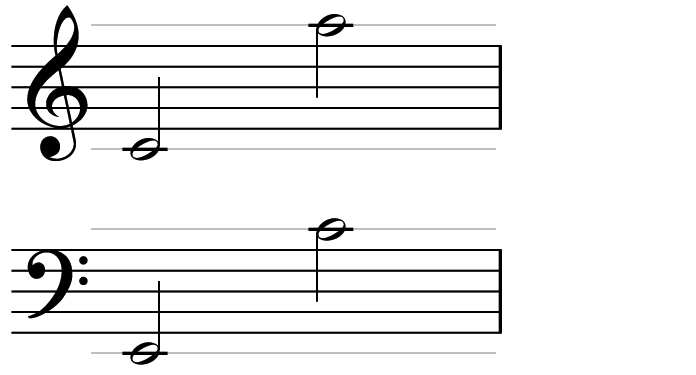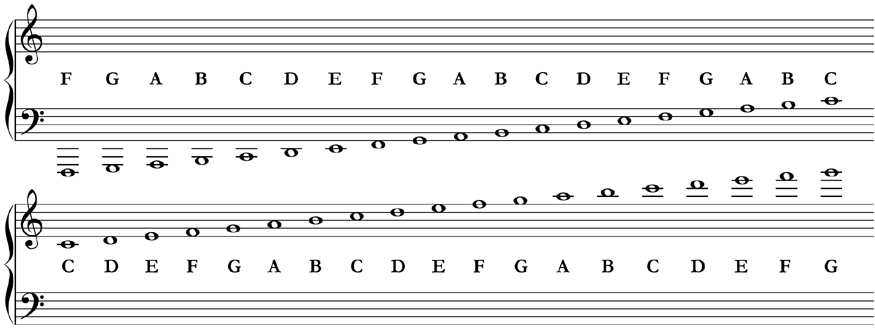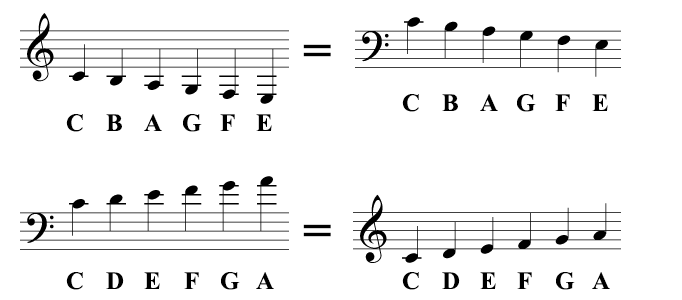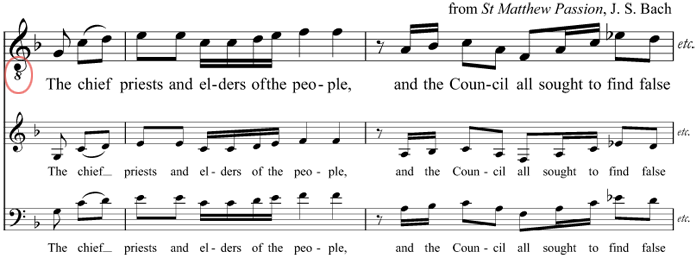Beyond the stave
In this guide...
Key terms:
Subscription required!
To view the complete study guide, you will need a valid subscription. Why not subscribe now?
Already have a subscription? Make sure you login first!
Introduction
You're probably familiar by now with locating and naming notes in the stave, using both treble and bass clef. Now it's time to look at what happens when we need to write down notes that are above or below the stave. Such notes obviously exist to play, but how do we notate them?
Middle C
First of all, let's have a reminder of the grand staff - the special name given to a pair of treble and bass staves linked together, on which you'd find, for example, piano music:
 The grand staff
The grand staffWe can clearly see middle C in the centre of the range in the grand staff. It doesn't fit into either the treble stave or the bass stave, and instead sits on a short line below the treble stave, or above the bass stave.
What is this short line?
In fact, it's just a short piece of stave-line and is called a ledger line.
Imagine an extra line running below the treble stave, so that there would be 6 lines and 5 spaces, rather than the familiar 5 lines and 4 spaces. It would make music quite difficult to read if there were 6 lines, so we only show the piece of the line that's needed for this note.
The same is true above the treble stave, to write a high A, and also above and below the bass stave, to write middle C and low E respectively.
The following example shows these imaginary lines in full, running through the ledger lines used for the relevant notes. Imagine having to read music that used 7 lines and 6 spaces!
 Imaginary extra stave lines, and the sections we use for ledger lines
Imaginary extra stave lines, and the sections we use for ledger linesLedger lines
When the grand staff is used for the piano, the notes are a continuous run from low to high, spanning both staves. However, there are obviously more notes on the piano than will fit onto a grand staff, even using a ledger line above (to reach high A) and below (to reach low E).
To solve this problem, we use as many extra ledger lines (i.e., pieces of many extra imaginary stave lines) as we need to write the note. The following example shows how we can extend the grand staff to write down much more of the piano's range.
 Extending the range of the grand staff using ledger lines
Extending the range of the grand staff using ledger linesMore than one ledger line
It is important to think of the notes as a continuous pattern; the notes in treble clef don't stop going down at C, and the notes in bass clef don't stop going up at C. The notes can be written in either clef, and we change clef only for convenience of not having to read too many ledger lines.
The next example shows how this is possible by matching up the same notes in treble and bass clef. These are the same notes: they are simply notated differently. Check these against the full run of notes in the previous example and make sure you understand how the notes continue smoothly from treble clef down to bass clef, and up from bass clef into the treble clef.
 These are exactly the same notes written in different clefs, using ledger lines
These are exactly the same notes written in different clefs, using ledger linesCorrect notation
Time for a quick handwriting tip!
When you are writing out a passage in which several neighbouring notes lie above or below the stave, don't join together the ledger lines.
Even though all the notes with ledger lines are using the same imaginary stave-lines, if you joined them together, the music would quickly become hard to read. Always leave a small gap between adjacent ledger lines.
The example below shows how hard it is to read music with joined-together ledger lines!
 Good and bad notation using ledger lines
Good and bad notation using ledger linesSecondly, always try to make sure that the gap between your ledger lines is the same as the gap between the lines of the stave. If your gap is narrower or wider, this will be unclear and make the music difficult to read.
Octave transposition
Several instruments frequently have to play notes above or below the stave - for example, the flute, the harp, or the piano. Even with ledger lines correctly notated (see above!), it can still be hard to read.
Sooner or later, it becomes much more practical to say "play all of these notes one octave higher", because it's much easier for the player to do that, than try to decipher many ledger lines. On the piano, it's especially easy, as the keys are conveniently laid out in a repeating pattern, so the player simply has to shift left or right to go an octave lower or higher!
There are some special shorthand symbols for this instruction. They all use the number 8 (for octave, i.e. an interval of an "8th"), and some include the letters "va" or "vb".
- 8va: short for the Italian all'ottava, meaning "at the octave" - an instruction to play one octave higher.
- 8vb: short for the Italian all'ottava bassa, meaning "at the octave below" - an instruction to play one octave lower.
 Different symbols in use to indicate octave transposition
Different symbols in use to indicate octave transpositionLoco
When you use an octave transposition sign, you'll often see the word loco after the transposed passage has finished. This is an additional reminder to the player to read the notes as normal, and to stop transposing. "Loco" is an Italian word meaning "place", and is intended to draw attention to the place of the notes on (for example) the keyboard.
Transposing clefs
You will also sometimes see a small figure "8" above or below a treble clef symbol. This has the same meaning - a treble clef with an 8 above means that all of the music is to be played an octave higher, and a treble clef with an 8 below means that the music should all be played an octave lower.
The case when you will often see a treble clef with an 8 below is in music written for the male tenor voice. While written in the treble clef, it sounds (i.e., it is sung) an octave lower.
The following example shows this type of treble clef in use, with a typical passage for the tenor voice, and for comparison, shows how the same music would look in both the standard treble and bass clefs - awkward, with lots of ledger lines!
 An octave-transposed treble clef in use, and the awkward alternatives
An octave-transposed treble clef in use, and the awkward alternativesRead more...
With a subscription to Clements Theory you'll be able to read this and dozens of other study guides, along with thousands of practice questions and more! Why not subscribe now?
Revision
Are you sure you've understood everything in this study guide? Why not try the following practice questions, just to be sure!